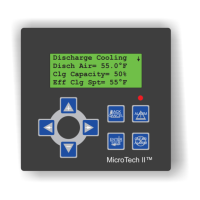OM 780-2 Page 67
• Tower Valve Propband
• Tower Valve Sample Time
• Tower Valve Integral Time
• Minimum Tower Valve Start-Up Position
• Maximum Tower Valve Start-Up Position
• Minimum Tower Valve Start-Up Position At (OAT)
• Maximum Tower Valve Start-Up Position At (OAT)
Chilled Water Flow Control
The CSM can maintain a constant differential pressure across the cooling loads by controlling a loop bypass valve, variable
speed cooling load pump(s), or a set of constant speed cooling load pumps. For applications that require a “lead/standby”
arrangement of two pumps, the CSM can automatically alternate the lead pump to equalize run time. To view the current
values of the load flow operation, go to the Flow screen. To configure the chilled water flow control operation, go to the
Load Flow Control screen to change the values described in Table 16.
Table 16. Load Flow Control (Main > Configuration > Load Flow Control)
Load Flow Control
Name Description
Pump Control
Option
If the CSM will be controlling cooling load pumping, set this value to meet the pump configuration. Range = None, One
Pump, Auto Lead, Pump 1 Lead, Pump 2 Lead, Sequencing, Multiple VFD Pumps. Default = None
Pump Status
Check Delay
Time
Used to determine a pumps alarm status. Any time the CSM has enabled a pump it monitors that pumps status switch. If
the status switch of an enabled pump is open, the CSM waits until this Pump Status Check Delay time expires before
setting the pump in alarm. Range = 1 to 60 seconds. Default = 30 seconds
Lead/Standby
Pump
Resequence
Day/Time
If the Pump Control Option is Auto Lead (or Pump 1 Lead or Pump 2 Lead and you have manually switched from one to
the other) this variable will force the running pump to be replaced by a new lead pump at a defined time. A requirement is
that the lead pump has changed to the non-operating pump during the continuous run period of the running pump. Default
= N/A
Resequence
Lead/Standby
Pumps NOW
If the Pump Control Option is Auto Lead (or Pump 1 Lead or Pump 2 Lead and you have manually switched from one to
the other) this button will force the running pump to be replaced by a new lead pump immediately. A requirement is that
the lead pump has changed to the non-operating pump during the continuous run period of the running pump.
Pump 1 Runtime
Reset
Pump 2 Runtime
Reset
Pump 3 Runtime
Reset
Pump 4 Runtime
Reset
Pump 5 Runtime
Reset
Pump 6 Runtime
Reset
The Pump Runtime Reset variables can be used to tell the CSM what the pump runtime value is for an existing pump.
Also, if an old pump is replace by a new pump, the runtime can be reset to zero. The CSM uses pump runtime to determine
a “lead” pump when Pump Control Option = Auto Lead. It also uses pump runtime to determine the next pump to enable
when Pump Control Option = Multiple VFD Pumps
Chilled Water
Loop Modulation
Control Option
If the CSM will be controlling the differential pressure across the load, set this value to meet the system configuration.
Range = None, Chilled Water Loop Bypass Valve, Pump VFD. Default = None
Loop Differential
Pressure Setpoint
This input is the user defined differential pressure across the load setpoint. If the Chilled Water Loop Modulation Control
Option = Chilled Water Loop Bypass Valve or Pump VFD, the output will be modulated to maintain the differential
pressure at this setpoint. If the Pump Control Option = Sequencing, pump stages will be increased to supply this
differential pressure. Range = 2 - 99 psi (13 – 683 kPa). Default = 10 psi (69 kPa)
Loop Differential
Pressure
Deadband
This value sets a Deadband around the Loop Differential Pressure Setpoint. No control action is taken when the current
Differential Pressure is within this Deadband around the Loop Differential Pressure Setpoint. Range = 0 – 9 psi (0 – 62
kPa). Default = 2 psi (13 kPa)
Loop Differential
Pressure
This value sets the “proportional band” used in the PID control function that modulates the loop differential pressure. In
general, increasing this value has a slowing effect and decreasing this value has a speeding effect on the control of the valve

